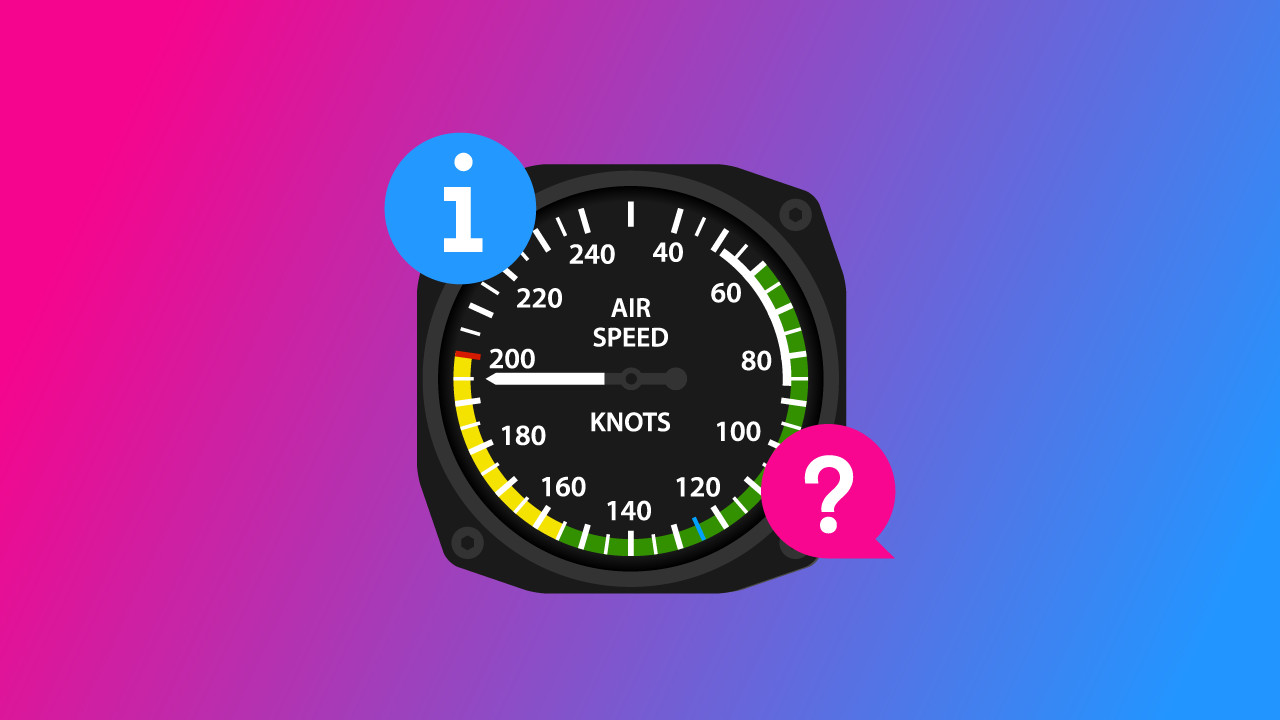-
Key Takeaways
-
What Are V-Speeds?
-
Mach Numbers and V-Speeds
-
V-Speeds List
-
Most Important V-Speeds Explained
- VR: Rotation Speed
- VX: Best Angle of Climb Speed
- VY: Best Rate of Climb Speed
- VA: Maneuvering Speed
- VFE: Maximum Flaps Extended Speed
- VLE: Maximum Landing Gear Extended Speed
- VNE: Never Exceed Speed
- VNO: Maximum Structural Cruising Speed
- VS: Stall Speed
- V1: Takeoff Decision Speed
- V2: Takeoff Safety Speed
- VEF: Critical Engine Failure Speed During Takeoff
- VMC: Minimum Control Speed
-
Final Thoughts
Ask a pilot how many V-speeds exist, and you’ll get an answer anywhere between “What’s a V-speed?” and “Probably a thousand.”
I’m happy to report that there aren’t a thousand, but there are a few you should be aware of.
In this article, we’ll explain everything you need to know about V-speeds. Plus, we’ve created a handy list so that you never have to Google them again.
Key Takeaways
- V-speeds provide safe aircraft operation.
- VX and VY optimize climb performance.
- VNE and VA prevent structural damage.
- VS0, VS1, VR, V1, and V2 guide key flight phases.
What Are V-Speeds?

V-speeds are specific airspeeds that are defined for operational reasons, such as limitations (e.g., maximum flaps extended speed – VFE) or performance requirements (e.g., best rate of climb speed – VY).
In other words, V-speeds serve as critical benchmarks that guide pilots in managing the aircraft’s performance and ensuring safety.
For example, the rotation speed (VR) is the speed at which the pilot initiates a gentle rotation of the aircraft to lift off the ground during takeoff.
A V-speed may change depending on factors such as aircraft weight and weather conditions, but its designation (e.g., VR) remains the same.
You may find several V-speeds on the internet that aren’t listed here. That’s because the V-speeds we’re talking about today are defined in 14 CFR Part 1, as well as 14 CFR Part 23 and Part 25 (used for aircraft certification).
Any other V-speeds you encounter are likely manufacturer-specific and aren’t regarded as official V-speeds by the Federal Aviation Administration (FAA).
Mach Numbers and V-Speeds

You may find V-speeds with an “M” instead of the usual “V” (MMO instead of VMO, for example).
This means that the particular speed is defined using a Mach number.
V-speeds can be defined using any type of airspeed, such as knots or miles per hour, but the designation remains “V” unless a Mach number is used – then it becomes “M”.
V-Speeds List
| V-Speed | Description |
| VA | Design maneuvering speed. |
| VB | Design speed for maximum gust intensity. |
| VC | Design cruising speed. |
| VD | Design diving speed. |
| VDF | Demonstrated flight diving speed. |
| VEF | Speed at which the critical engine is assumed to fail during takeoff. |
| VF | Design flap speed. |
| VFC | Maximum speed for stability characteristics. |
| VFE | Maximum flap extended speed. |
| VFTO | Final takeoff speed. |
| VH | Maximum speed in level flight with maximum continuous power. |
| VLE | Maximum landing gear extended speed. |
| VLO | Maximum landing gear operating speed. |
| VLOF | Lift-off speed. |
| VMC | Minimum control airspeed with the critical engine inoperative. |
| VMO | Maximum operating limit speed. |
| VMU | Minimum unstick speed. |
| VNE | Never-exceed speed. |
| VNO | Maximum structural cruising speed. |
| VR | Rotation speed. |
| VREF | Reference landing speed. |
| VS | Stalling speed or minimum steady flight speed at which the airplane is controllable. |
| VS0 | Stall speed in the landing configuration. |
| VS1 | Stall speed in a specific configuration (e.g., ‘clean’ configuration). |
| VSR | Reference stall speed. |
| VSR0 | Reference stall speed in the landing configuration. |
| VSR1 | Reference stall speed in a specific configuration. |
| VSW | Speed at which onset of natural or artificial stall warning occurs. |
| VTOSS | Takeoff safety speed for Category A aircraft. |
| VX | Speed for best angle of climb. |
| VY | Speed for best rate of climb. |
| V1 | Takeoff decision speed. |
| V2 | Takeoff safety speed. |
| V2min | Minimum takeoff safety speed. |
Most Important V-Speeds Explained
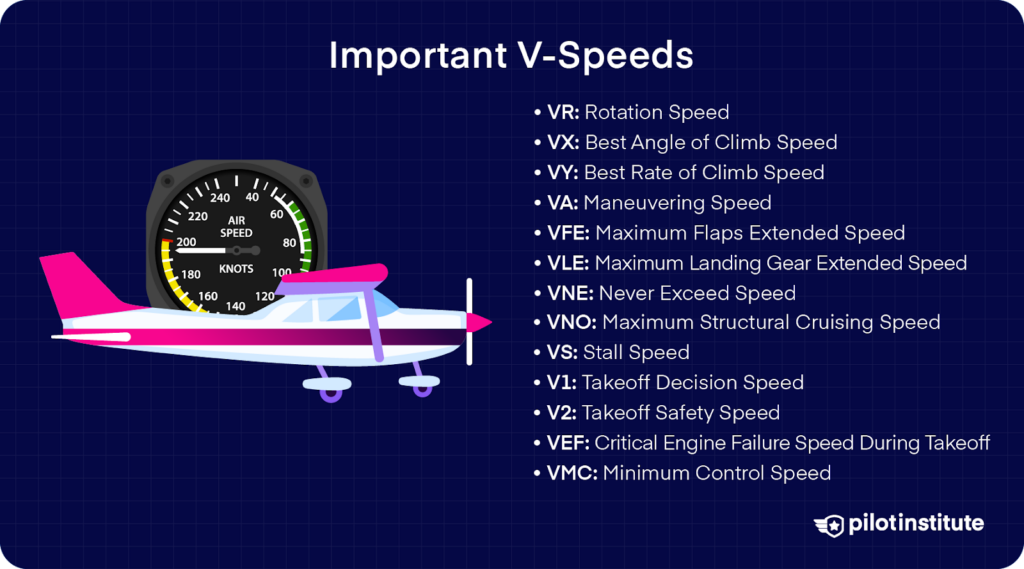
Let’s take a look at the V-speeds you’re most likely to encounter – and the ones you should know.
As we go through them, use the Pilot’s Operating Handbook (POH) for the airplane you fly, and make a note of the speed for each V-speed. If it isn’t defined in the POH or is variable, make sure you know how to calculate it.
You’ll make your life a whole lot easier if you take the time to memorize them.
VR: Rotation Speed
VR is the speed at which the pilot gently pulls back on the control column to lift the nose off of the runway during takeoff.
For most commercial aircraft, VR varies for each takeoff depending on the weight and configuration of the aircraft as well as environmental factors like weather or runway conditions.
In most General Aviation (GA) aircraft, VR is usually the same regardless of conditions.
It might seem obvious, but VR cannot be less than the stall speed (VS1 – more on that later).
VX: Best Angle of Climb Speed
VX is the airspeed that provides the best angle of climb. In other words, if you maintain VX, you’ll gain the most altitude in the shortest horizontal distance.
This speed is your go-to for a short-field takeoff, particularly when there are obstacles that you need to climb above during takeoff.
You should practice climbing at VX (and short-field takeoffs) regularly, as it is a critical skill during short-field operations.
VY: Best Rate of Climb Speed
VY is the airspeed for best rate of climb. In other words, if you maintain VY, you’ll gain the most altitude in the shortest amount of time.
Compared to VX, you’ll use more horizontal distance.
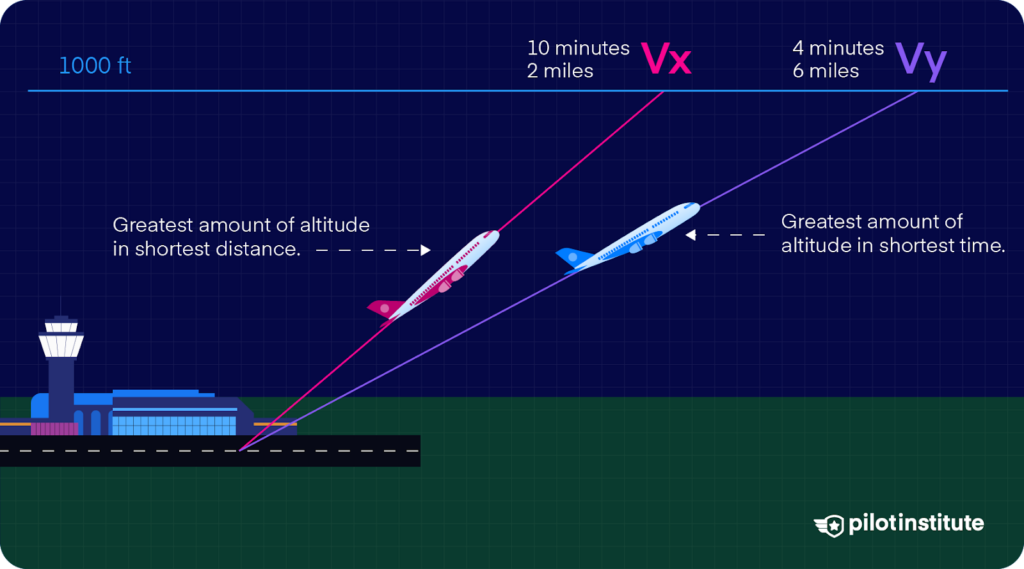
VY is the speed typically used during climb.
VA: Maneuvering Speed
VA is the aircraft’s design maneuvering speed. It is the speed above which you risk damaging the aircraft’s structure if you make a full deflection of a flight control (e.g., full-up elevator).
If you make a full deflection of a flight control at or below VA, the aircraft will stall before the structure is damaged.
You should not use full deflection of any flight control above VA. That being said, repeated full deflection of any flight controls (such as full right rudder and then full left rudder, for example) is not recommended, even below VA.
VA isn’t a fixed figure; it varies with weight. If the aircraft’s weight decreases, VA decreases as well, and vice versa.
VFE: Maximum Flaps Extended Speed
VFE, or maximum flap extended speed, is the highest speed permissible with the flaps extended.
This speed is your boundary marker when flying with flaps down, ensuring you don’t cause potential structural damage.
Not all aircraft treat VFE as a singular speed regardless of flap setting. Most aircraft, like the Cessna 172, have different VFE speeds for different flap settings.
In the Cessna 172, you can fly with 10 degrees of flaps below 110 knots. Anything more than 10 degrees of flaps, and you’re limited to 85 knots instead.
VLE: Maximum Landing Gear Extended Speed
VLE, or maximum landing gear extended speed, is the top speed at which you can safely fly with the landing gear extended.
A related speed is VLO, or maximum landing gear operating speed, the speed above which you cannot extend or retract the landing gear.
VLO is typically lower than VLE due to the aerodynamic forces exerted on the landing gear during extension or retraction.
VNE: Never Exceed Speed
VNE, or “never exceed” speed, is exactly that. The speed above which you should never venture under any circumstances.
VNO: Maximum Structural Cruising Speed
VNO, the maximum structural cruising speed, is the highest speed that you can safely fly in smooth air.
VNO is marked by the upper limit of the green arc on the airspeed indicator.
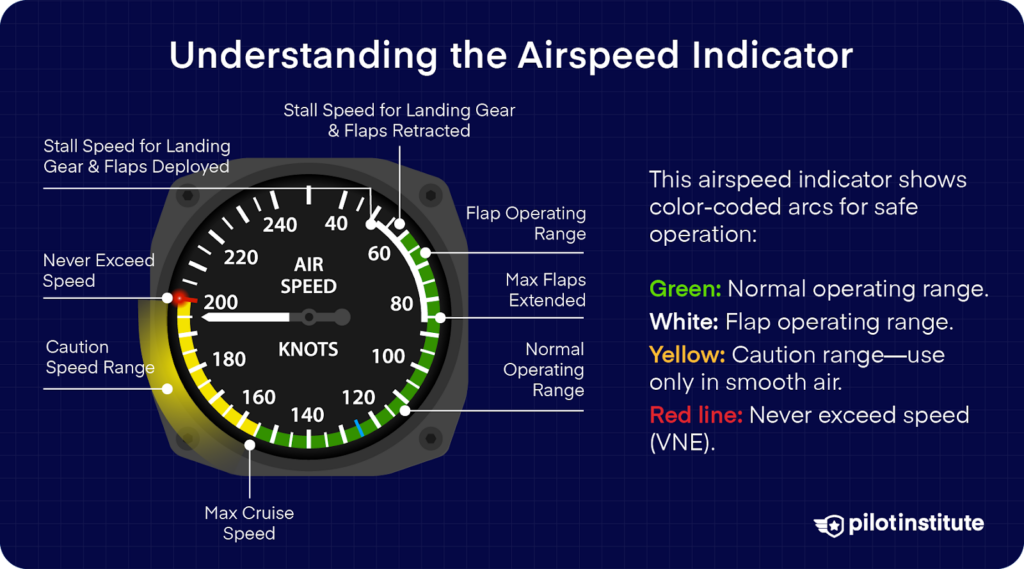
If you’re above VNO (in the yellow arc or “caution range”) and you encounter air that is not smooth, you could cause damage to the aircraft.
For example, if you encounter turbulence, the “bumps” you experience will increase the load factor. If you fly above VNO in these conditions, the increase in load factor could damage the aircraft’s structure.
VS: Stall Speed
VS represents stall speed, essentially the lowest speed at which your aircraft can maintain steady flight.
When it comes to VS, there’s an important caveat.
An aircraft can stall at any speed.
A stall occurs when the aircraft exceeds the critical angle of attack. This can happen at any airspeed.
Say a pilot is descending at a high airspeed, far from VS. If they quickly pitch up, the aircraft may exceed the critical angle of attack and stall, despite being at a high airspeed.
So, why do we define VS?
Well, in a “normal” attitude (think straight-and-level), the aircraft is only at risk of stalling if:
- The pilot makes a dramatic control input that quickly increases the angle of attack, or
- The pilot maintains altitude while the airspeed decreases, gradually increasing the angle of attack and eventually stalling at VS.
So, can the aircraft stall at any airspeed? Yes.
When is it most likely to stall? At VS.
The V-speed for stall speed is divided into two types:
- VS0 – the stall speed in the landing configuration (e.g., flaps and gear down)
- VS1 – the stall speed in a specific configuration (e.g., ‘clean’ – flaps and gear up)
The difference between the stall speed with the flaps down versus the flaps up is significant, so it makes sense to differentiate between the two.
One final note about VS.
Every manufacturer determines the stall speed for their aircraft. The test for stall speed is performed with the throttle closed at maximum takeoff weight.
This means that you may experience a lower stall speed than published in the POH if you’re flying at a lower weight or the throttle isn’t closed.
For more information on stall speed testing regulations, see AC 23-8C, § 23.49, page 15.
V1: Takeoff Decision Speed
V1, or the takeoff decision speed, is the speed by which the decision to continue the takeoff or abort must be made.
The primary purpose of V1 is to serve as a decision point. If a critical system fails (such as an engine) or other anomalies occur before reaching V1, there will be sufficient runway remaining to abort the takeoff safely.
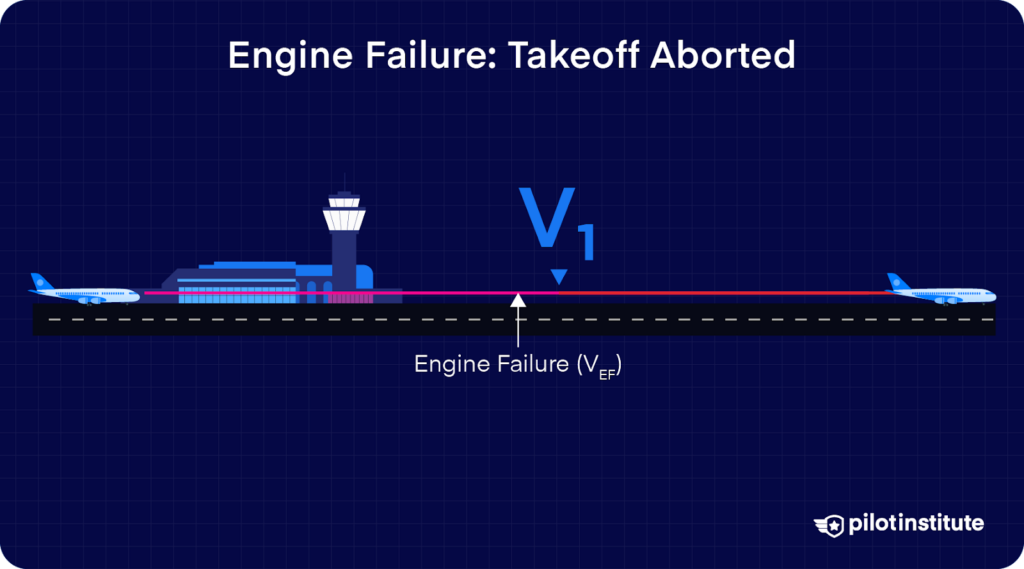
However, once V1 is surpassed, the takeoff should continue, as there will not be enough runway left to stop safely.
V1 is not a fixed number and is calculated before each takeoff, taking into account several factors, including aircraft weight, runway length, environmental conditions, and aircraft performance data.
V1 is where the pilot must take the first action (such as reducing thrust) to stop the aircraft or risk a runway overrun.
It’s important to note that V1 also relates to the aircraft’s performance capability in case of an engine failure. After V1, the aircraft must have the performance capability to continue the takeoff on the remaining engines and achieve the required climb performance.
That’s where V2, or takeoff safety speed, comes into play.
V2: Takeoff Safety Speed
V2, known as the takeoff safety speed, is the minimum speed at which the aircraft can maintain a specified rate of climb with one engine inoperative.
The primary goal of V2 is to ensure a safe climb gradient in an engine failure scenario. This speed ensures that the aircraft can maintain a positive rate of climb to clear obstacles and reach a safer altitude.
The aircraft must be able to achieve V2 at a minimum of 35 ft above the end of the runway distance after an engine failure at V1.
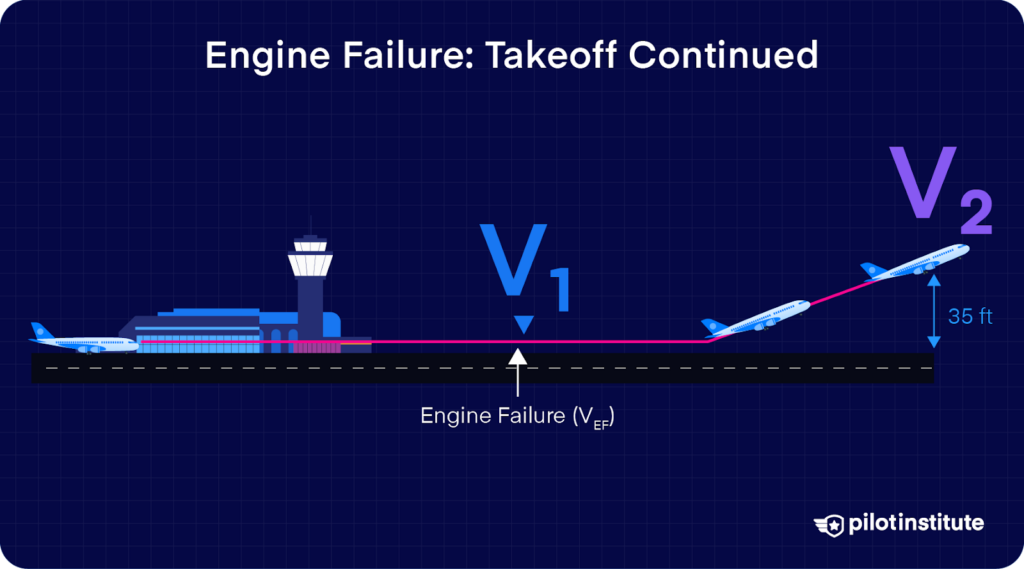
VEF: Critical Engine Failure Speed During Takeoff
VEF is the worst possible speed the critical engine can fail while allowing the takeoff to be completed successfully.
Interestingly, it is not at V1, but actually before.
This may sound strange, because we should abort the takeoff if an engine failure occurs before V1, right?
Well, regulations state that takeoff performance calculations should account for an engine failure that is close enough to V1 that the pilot does not have enough time to abort at V1.
In other words, if the engine fails right before V1 without enough time to react, the aircraft must be able to take off safely and achieve V2 at the specified height and distance.
VMC: Minimum Control Speed
VMC, or minimum control speed, represents the lowest speed at which a multi-engine aircraft can maintain controlled flight with one engine inoperative and the other at full power.
VEF may not be less than VMC, and V2min may not be less than 1.1 times VMC.
VMC is often divided into two distinct speeds: VMCA and VMCG, each addressing a different aspect of aircraft control under asymmetric thrust conditions.
VMCA: Minimum Control Speed Air
VMCA is the minimum speed at which the aircraft can maintain controlled flight in the air with one engine failing and the other at full power.
Below VMCA, the aircraft may become uncontrollable due to the loss of directional control, making it a critical speed to be aware of during flight operations.
VMCG: Minimum Control Speed Ground
VMCG, on the other hand, is the minimum speed at which the aircraft can maintain directional control on the ground, with one engine inoperative and the other at full power.
It’s vital to know the speed during the takeoff roll to ensure that control can be maintained if an engine fails during takeoff.
Final Thoughts
V-speeds are critical references that ensure safety and efficiency. They are the result of meticulous calculations and real-world testing and shouldn’t be disregarded.
You may have even encountered these speeds when flying without knowing it
One thing’s for sure: you’ll notice them now!
